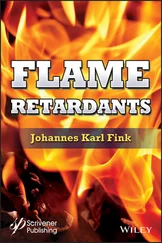1 ...8 9 10 12 13 14 ...36 42. Hirschler, M.M., Procedures for development and revision of codes and standards associated with fire safety in the USA. Fire Mater ., 41 , 1058–1071, 2017.
43. United Nations, Stockholm Convention on persistent organic pollutions (POPs) , 2017 latest revision, www.pops.int(accessed 03/29/21).
44. https://www.epa.gov/saferchoice/partnership-evaluate-flame-retardant-alternatives-decabde-publications(accessed 09/08/20).
45. https://www.epa.gov/saferchoice/partnership-evaluate-flame-retardant-alternatives-hbcd-publications(accessed 09/08/20).
46. https://www.epa.gov/assessing-and-managing-chemicals-under-tsca/polybrominated-diphenyl-ethers-pbdes(accessed 09/08/20).
47. https://www.epa.gov/assessing-and-managing-chemicals-under-tsca/polybrominated-diphenylethers-pbdes-significant-new-use(accessed 09/08/20).
48. https://www.epa.gov/assessing-and-managing-chemicals-under-tsca/risk-management-hexabromocyclododecane-hbcd(accessed 09/08/20).
49. https://www.epa.gov/sites/production/files/2018-06/documents/hbcd_problem_formulation_05-31-18.pdf(accessed 09/08/20).
50. https://www.epa.gov/saferchoice/design-environment-alternatives-assessments(accessed 03/28/21).
51. USA Federal Hazardous Substances Act (FHSA), Consumer Product Safety Commission (CPSC) 82 FR 45268.
52. https://www.saferstates.com/toxic-chemicals/toxic-flame-retardants/(accessed 09/07/20).
53. https://www.canada.ca/en/environment-climate-change/services/canadian-environmental-protection-act-registry/related-documents.html(accessed 09/07/20).
54. https://en.wikipedia.org/wiki/Registration,_Evaluation,_Authorisation_and_Restriction_of_Chemicals(accessed 09/07/20).
55. https://en.wikipedia.org/wiki/China_RoHS(accessed 09/07/20).
56. https://www.meti.go.jp/policy/chemical_management/english/cscl/(accessed 09/07/20).
57. https://www.nite.go.jp/en/chem/kasinn/lists.html(accessed 09/07/20).
58. http://www.cirs-reach.com/KoreaTCCA/Korea_Toxic_Chemicals_Control_Act_TCCA.html(accessed 09/07/20).
59. https://www.industrialchemicals.gov.au/(accessed 09/07/20).
60. Wilkie, C.A. and Morgan, A.B. (Eds.), Fire Retardancy of Polymeric Materials , 2nd Edition, Taylor and Francis, Boca Raton, FL, 2010.
61. Morgan, A.B. and Gilman, J.W., An overview of flame retardancy of polymeric materials: application, technology, and future directions. Fire Mater ., 37 , 259–279, 2013.
62. Weil, E.D., Levchik, S., Moy, P., Flame and Smoke Retardants in Vinyl Chloride Polymers – Commercial Usage and Current Developments. J. Fire Sci ., 24 , 211–236, 2006.
63. Cleanroom Materials Flammability Test Protocol, in: FM Global Standard 4910 , Factory Mutual Research Corporation, Norwood, MA USA, 2013.
64. Fire and Toxicity Test Methods and Qualification Procedure for Composite Material Systems Used in Hull, Machinery, and Structural Applications Inside Submarines , MIL-STD 2031, US Department of Defense, Washington, DC, USA, 26 February 1991.
65. Flammability, Offgassing, and Compatibility Requirements and Test Procedures , NASA-STD-6001, US National Aeronautics and Space Administration, US National Aeronautics and Space Administration, Washington, DC, USA, 2011-08-26.
66. https://en.wikipedia.org/wiki/Blue_Angel_(certification)(accessed 09/07/20).
67. https://en.wikipedia.org/wiki/EU_Ecolabeland www.ecolabel.eu(accessed 09/07/20).
68. https://en.wikipedia.org/wiki/Nordic_swan(accessed 09/07/20).
69. https://en.wikipedia.org/wiki/Green_Seal(accessed 09/07/20).
70. https://www.globalgreentag.com/(accessed 09/07/20).
71. Sundström, B. (Ed.), Fire Safety of Upholstered Furniture – The Full Report of the European Commission Research Programme CBUF , Interscience Communications Ltd, London, 1995.
72. Cleary, T.G., Ohlemiller, T.J., Villa, K., The influence of ignition source on the flaming fire hazard of upholstered furniture. Fire Saf. J ., 23 , 79–102, 1994.
73. Kramer, R.H., Zammarano, M., Linteris, G.T., Gedde, U.W., Gilman, J.W., Heat release and structural collapse of flexible polyurethane foam. Polym. Degrad. Stab , 95 , 1115–1122, 2010.
74. Lefebvre, J., Le Bras, M., Bastin, B., Paleja, R., Delobel, R., Flexible Polyurethane Foams: Flammability. J. Fire Sci ., 21 , 343–367, 2003.
75. Pau, D.S.W., Fleischmann, C.M., Spearpoint, M.J., Li, K.Y., Thermophysical properties of polyurethane foams and their melts. Fire Mater ., 38 , 433–450, 2014.
76. Technical Bulletin 117-2013, Requirements, Test Procedure and Apparatus for Testing the Smolder Resistance of Materials Used in Upholstered Furniture , Department of Consumer Affairs, State of California, January 2019, https://bhgs.dca.ca.gov/laws/tb117_2013.pdf(accessed 04/14/20).
77. Butry, D.T. and Thomas, D.S., Cigarette Fires Involving Upholstered Furniture in Residences: The Role That Smokers, Smoker Behavior, and Fire Standard Compliant Cigarettes Play. Fire Technol ., 53 , 1123–1146, 2017.
78. Storesund, K., Steen-Hansen, A., Bergstrand, A., Fire safe upholstered furniture: Alternative strategies to the use of chemical flame retardants, in: SP Fire Research Report SPFR Report A15 20124:2, December 12, 2015.
1 Email: alexander.morgan@udri.udayton.edu
2
Phosphorus-Based Flame Retardants
Sergei Levchik
ICL-IP America, 769 Old Saw Mill River Rd., Tarrytown, NY, USA
Abstract
Because phosphorus chemistry is very diverse there are many classes of phosphorus-based flame retardants with specific applications. Red phosphorus is a unique flame retardant which is used in its elemental form. Despite being very flammable in air, red phosphorus is a very efficient flame retardant mostly for thermoplastic polyesters and polyamides. Most inorganic phosphates are water soluble and because of this they are used as non-durable treatment for textiles and wood. Water insoluble ammonium polyphosphate, piperazine polyphosphate and melamine phosphates are very efficient flame retardants especially for polyolefins. Aluminum and calcium hypophosphites and aluminum diethyl phosphinate were introduced to the market about two decades ago but are still actively researched for new applications by industrial labs and for mechanisms of action by academic institutions. Aliphatic phosphates and phosphonates and aromatic phosphates are the oldest classes of organophosphorus flame retardants and plasticizers with well-established applications. Aromatic bisphosphates are broadly used in polycarbonate-based and polyphenylene ether-based blends but their market share grows mostly because these types of thermoplastics grow fast. Fueled by a fast growing sector of high speed and high frequency printed wiring boards, aromatic phosphinates, phosphine oxides and phosphazenes are the most active areas of research both in industry and in academia.
Keywords:Phosphorus flame retardant, intumescent, char, plastic, textile, epoxy resin, polyurethane foam
It is generally accepted that the most efficient flame retardants provide their action both in the condensed and gas phases. Although halogen- and phosphorus-based flame retardants exhibit these two mechanisms of action, the difference is that halogen flame retardants can promote charring of most organic polymers by bromine radicals abstracting hydrogen atoms from polymer chains resulting in formation of double bonds or cross-links [1]. Phosphorus flame retardants are more specific to the polymer chemistry than halogen ones and they are mostly effective in the oxygen- or nitrogen-containing polymers due to the fact they need to react with the polymer e.g., phosphorylate it and thus involve it in the charring. The char impedes the heat flux to the polymer surface and retards diffusion of the volatile pyrolysis products to the flame.
Читать дальше












